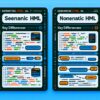Enhancing SEO with Semantic HTML: Tips and Tricks

Semantic HTML plays a crucial role in enhancing Search Engine Optimization (SEO) by ensuring that the content on a webpage is not only human-readable but also machine-understandable. In this article, we’ll delve into how making use of Semantic HTML can significantly boost your SEO efforts and provide practical tips and tricks to effectively implement it.
Understanding Semantic HTML
Before diving into the tips and tricks, let’s first understand what Semantic HTML is. Semantic HTML involves using HTML tags to convey the meaning and structure of the content without resorting to custom tags and attributes. This includes tags like ;<article>>, ;<section>>, ;<nav>>, and ;<header>> that clearly define the part of the webpage they’re marking up.
Why Semantic HTML Matters for SEO
Search engines like Google rely heavily on the structure of a webpage to understand its content and relevance to a user’s query. By using Semantic HTML, you’re essentially providing a clear roadmap of your content, making it easier for search engines to index and accurately rank your website. This can lead to better visibility and higher rankings in search results.
Enhanced Accessibility
Semantic HTML also improves the accessibility of your website, making it more usable for people with disabilities. This inclusivity can positively affect your site’s reputation and by extension, its SEO rankings.
Tips and Tricks for Enhancing SEO with Semantic HTML
Use Heading Tags Wisely
– Start with an ;<h1>> tag for your main title to establish the primary topic of your page. It’s important for SEO to have only one ;<h1>> per page.
– Use ;>
, ;>
, and so on, for subheadings to create a structured outline of your content. This helps search engines understand the hierarchy and significance of your content.
Implement Descriptive Sectioning
– Use ;<article>> for standalone content that would make sense on its own, like a blog post.
– The ;<section>> tag is your friend for grouping related content under a common theme.
– Don’t forget ;<nav>> for navigation menus, and ;<aside>> for sidebar content, to further enhance the semantic structure of your site.
Link Internally with the
;<nav>> ElementEnhance your site’s SEO by structuring your navigation semantically. A properly marked-up ;<nav>> element can guide search engines more effectively through your site, improving indexing and page rank.
Emphasize Important Text
– Utilize ;<strong>> and ;<em>> to indicate text of importance and emphasis, respectively. This not only makes your content more accessible but also signals to search engines aspects of your content that are particularly relevant to its meaning.
Utilize the
;<footer>> TagDon’t neglect the ;<footer>> tag. Including it helps define the end of your page and can be a good place to summarize your page’s content with relevant keywords, contributing positively to your SEO.
Conclusion
Incorporating Semantic HTML into your web development process can significantly enhance your SEO strategy. It makes your site more understandable to both users and search engines, leading to better indexing, higher rankings, and potentially more traffic. By following these tips and tricks, you’ll be well on your way to creating content that not only speaks to your audience but is also favored by search engines.


